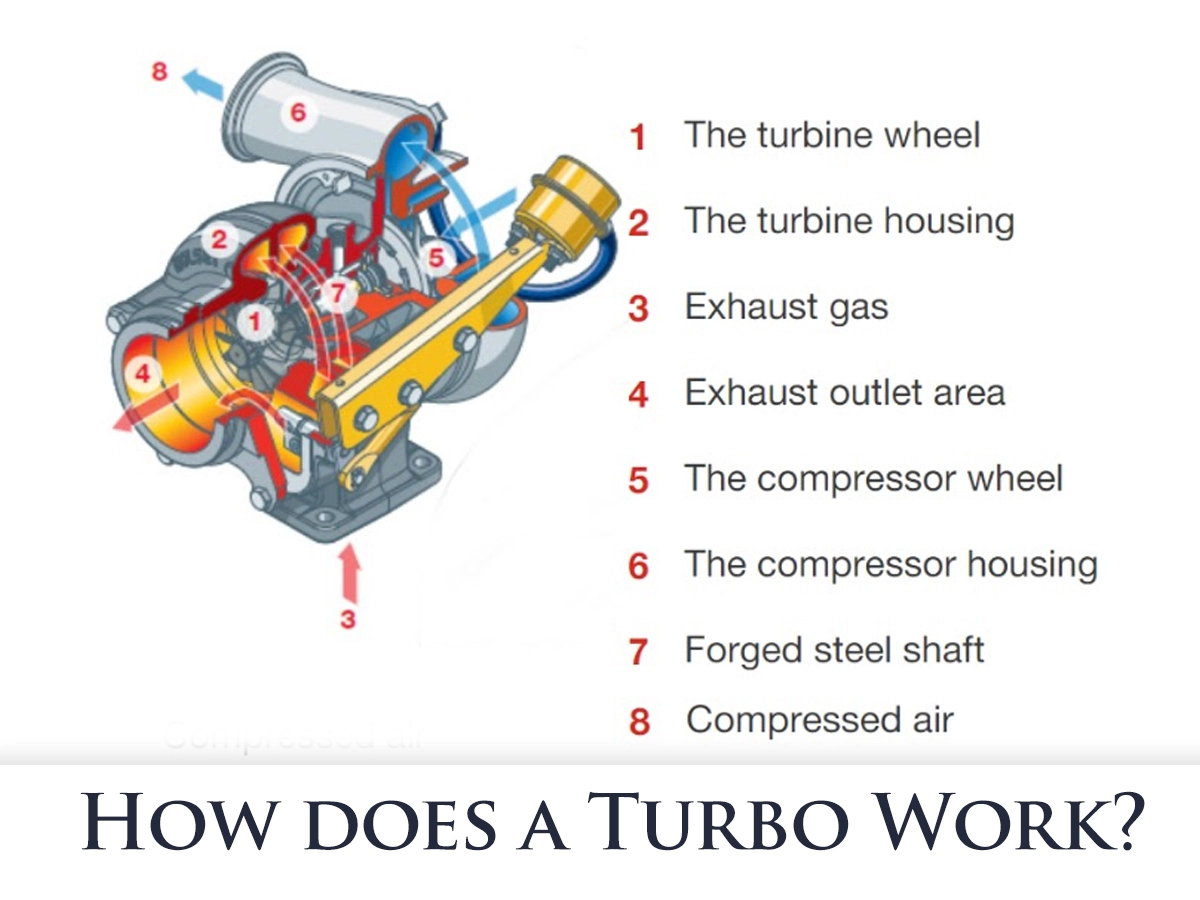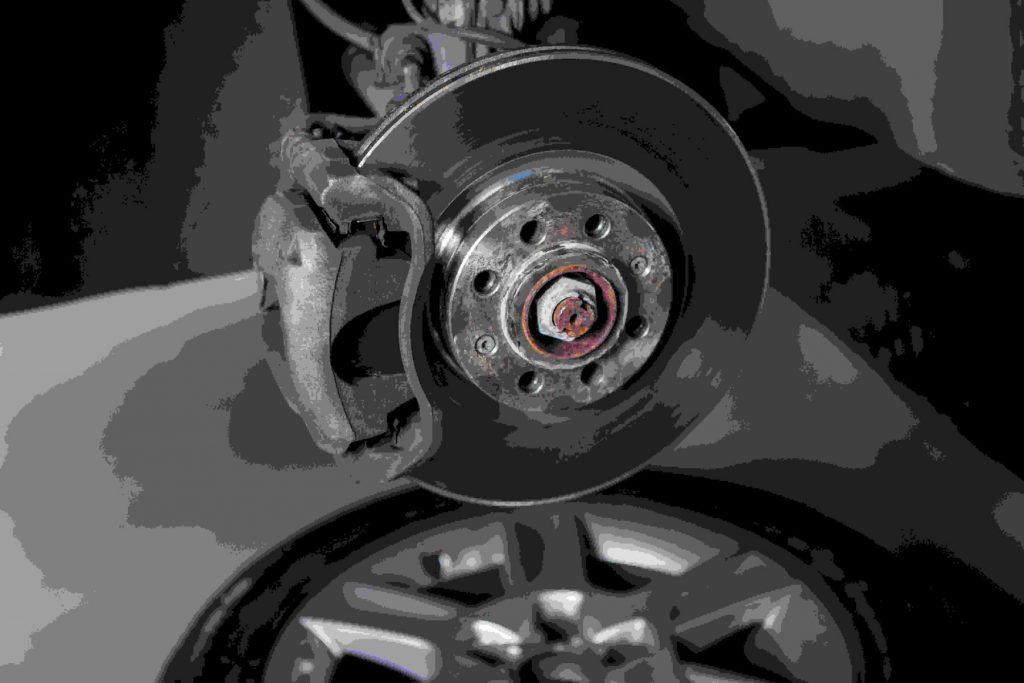At Burj Malabar Auto Maintenance in Sharjah, we often get asked how much extra horsepower a turbocharger can add to a car’s engine. Turbocharging is a popular way to boost engine performance, especially for passenger cars, by forcing more air into the engine to burn more fuel and produce more power. In this article, we’ll break down how turbochargers work to increase horsepower, explain how much of a horsepower gain you can expect from adding a turbo, and discuss the key factors that influence those gains.
How Turbochargers Increase Horsepower
Turbochargers are a form of forced induction – they compress the air entering the engine, allowing significantly more air (and fuel) into the cylinders than a normal engine would inhale on its own. In simple terms, the turbo uses energy from the engine’s exhaust gases to spin a turbine, which drives an air compressor. This cram of extra oxygen enables the engine to burn more fuel with each combustion, resulting in a stronger explosion in the cylinder and thus more horsepower. Essentially, a turbocharged engine of a given size can produce more power than the same engine without a turbo because it’s burning more air-fuel mixture on each stroke.
One major advantage of turbocharging is improving the engine’s power-to-weight ratio. Instead of using a much larger engine to get more power, a smaller turbocharged engine can achieve similar horsepower more efficiently. This is why modern manufacturers often use turbochargers on small engines – you get the power of a bigger engine without the extra weight or fuel consumption penalty. For example, many 4-cylinder engines today can make the kind of power that older V6 engines did, thanks to turbos. In fact, a turbocharged four-cylinder can produce power comparable to a larger V6, and a turbo V6 can even match the output of a traditional V8 with no loss of performance. We have seen this trend in Sharjah as well, where smaller turbo engines are common in new cars, offering strong performance with better fuel economy.
How Much Horsepower Can a Turbo Add?
So, how much extra horsepower does adding a turbocharger actually provide? The answer depends on the boost pressure and efficiency of the setup, but generally a turbo can increase an engine’s output dramatically. A typical aftermarket turbo installation running moderate boost (around 6–8 psi) can yield roughly a 30% to 40% increase in horsepower over the engine’s naturally aspirated output. This boost level packs in about 50% more air than atmospheric pressure alone (14.7 psi at sea level), which in theory could give about 50% more power – though in practice, real-world inefficiencies (like heat and exhaust backpressure) make the actual gain a bit lower, around one-third more power rather than one-half. In other words, if your engine produced 200 HP without a turbo, adding a turbo might raise it to roughly 260–280 HP in a well-tuned setup. Even a conservative boost can add a substantial bump in power; for instance, a small 4-cylinder making 150 HP might reach ~200 HP with a mild turbo (an extra 50 HP), whereas a more aggressive boost on the same engine could push it to 225+ HP (a 50% gain).
It’s important to note that horsepower gains from a turbo can vary widely. Depending on the turbo size, engine internals, and tuning, we’ve observed gains as low as ~10% and as high as 50% or more. Generally, smaller engines (with lower baseline HP) see a larger percentage increase from turbocharging than big engines do, because there’s more headroom for improvement relative to their starting power. As one expert put it, “smaller engines experience more significant power gains due to their lower baseline output,” meaning a tiny engine can often double its power with forced induction, while a larger engine might gain a smaller percentage. For example, an economy 1.0L engine that makes 75 HP stock could jump to ~120–130 HP with a turbo (adding ~50–70% more power), whereas a 3.0L V6 making 230 HP might go to around 310 HP with a turbo (adding ~35% more). The comparison table below provides some illustrative examples of horsepower gains with turbocharging:
| Engine (Example) | Stock NA Horsepower | Turbocharged Horsepower | HP Increase | Increase (%) |
|---|---|---|---|---|
| Small 1.0L 3-cyl (e.g. city car) | 75 HP | ~125 HP | +50 HP | ~+67% |
| Mid-size 2.0L 4-cyl (e.g. sedan) | 150 HP | ~225 HP | +75 HP | ~+50% |
| Larger 3.0L V6 (e.g. SUV) | 230 HP | ~310 HP | +80 HP | ~+35% |
Table: Approximate horsepower gains from turbocharging for different engine sizes (assuming ~6–10 psi boost and proper tuning). Actual results vary with specific engine and turbo setup.
As shown above, a turbo can transform an engine’s output significantly – a modest family sedan’s engine might suddenly produce the kind of power you’d expect from a sports car. In Sharjah, where many drivers seek extra performance for highway merging or desert driving, we’ve seen how a properly turbocharged four-cylinder can rival a stock six-cylinder. Keep in mind that these figures assume the rest of the system can support the extra power (fuel, cooling, etc.). In an ideal scenario with perfect efficiency, a turbo could add about 50% more horsepower, but real-world gains tend to be a bit lower in the 30–40% range for a well-implemented turbo system. And with more extreme tuning (higher boost and engine modifications), exceeding a 50% power increase is possible – large turbo setups have achieved power gains that far exceed 30–50% of the engine’s original output in specialized builds.
Factors Affecting Turbo Horsepower Gains
Not every turbo setup will yield the same results – several key factors influence how much horsepower a turbocharger will add to your particular vehicle. We at Burj Malabar always evaluate these factors when advising clients on turbo modifications:
- Turbocharger Size & Design: The size and type of the turbo heavily affect power delivery. A small turbo spools up quickly (minimal lag) but can only push a limited amount of air, capping the horsepower gain. A larger turbo or multi-turbo setup (e.g. twin turbos) can flow much more air for bigger peak gains, but may take longer to reach full boost (more turbo lag). Selecting the right turbo size/design involves balancing quick response versus maximum airflow, and it should match your engine’s characteristics. We consider this balance to ensure you get a usable power band for daily driving, not just a big peak number.
- Boost Pressure Level: Boost is the amount of pressure the turbo generates above atmospheric pressure. More boost generally means more power, but only up to what the engine can handle. Most stock engines can safely take a modest boost (around 5–7 psi) with proper tuning. Going to higher boost levels (e.g. 8–12+ psi) often requires upgraded internal engine components (stronger pistons, forged rods, improved head gaskets, etc.) to survive the extra strain. Exceeding the safe boost limit can lead to engine knocking (pre-ignition due to high compression heat) and mechanical failure if not managed. That’s why performance builders reinforce engines for high-boost builds and use high-octane fuel to prevent knock. In short, the horsepower a turbo adds will climb with boost pressure, but only to the point that your engine’s design (and fuel quality) allows it to harness this additional pressure safely.
- Fuel System & Tuning: A turbo by itself only pumps in extra air – to actually get more power, the engine needs to mix that air with more fuel. Thus, your fuel delivery system (fuel pump, injectors, lines) must be capable of supplying the additional fuel needed for combustion at higher airflow. We always ensure that a car’s injectors and pump can handle the demand; otherwise, the mixture will go lean and not gain power (or worse, cause engine damage). Equally important is engine tuning (ECU remapping). Proper tuning adjusts parameters like fuel injection timing, ignition timing, and boost control to optimize the combustion with the turbo. For example, ignition timing often needs to be retarded slightly under boost to avoid knock, and the air-fuel ratio is enriched (often around 11.5–12:1 under boost vs. 14.7:1 normally) for safe power. Without the right tune, you won’t see the full horsepower benefit, and reliability could be compromised. That’s why we recommend professional installation and tuning for aftermarket turbos – it ensures you get maximum power gains safely.
- Intercooling & Air Temperature: Compressing air with a turbo heats it up (hot air is less dense), which can reduce power if not addressed. An intercooler is a heat exchanger that cools the turbocharged air before it enters the engine, increasing its density and oxygen content for better combustion. Effective intercooling can substantially improve horsepower by delivering cooler, denser air – for example, an intercooled 7 psi boost will make more power than 7 psi of hot, non-intercooled air. In our hot Sharjah climate, intercoolers are especially vital; the ambient temperatures here can be extreme, so keeping the intake air cool makes a big difference in maintaining power. We ensure any turbo setup includes a properly sized intercooler (and sometimes water/methanol injection or upgraded radiators) to manage intake and engine temperatures. Good intercooling not only adds horsepower but also provides a safety margin against knock in high-boost operations.
- Engine Internal Strength: The engine’s internal components must withstand the increased pressures and forces that come with turbocharging. A turbo dramatically raises cylinder pressure and temperature, which puts extra stress on pistons, connecting rods, crankshaft, head gasket, and valves. If these parts are weak or not designed for boost, there’s a limit to how much power you can add before risking a failure. Many modern engines are built with some margin (since even factory turbo models exist based on similar blocks), but older or economy engines might need upgrades for significant boosts. For example, beyond a certain horsepower or boost level, forged pistons and rods, stronger head bolts, and lower compression ratios may be required to handle the forces. As a rule of thumb, we find that staying in the ~30-40% power increase range on a stock engine is usually safe, but pushing to 50%+ gain often calls for internal fortifications. This is another reason why high horsepower turbo builds should be done with careful engineering and why professional oversight is recommended – it ensures longevity along with that big power jump.
- Supporting Systems (Exhaust & Intake): Lastly, the rest of the engine’s breathing system influences turbo performance. A turbo relies on exhaust flow to spin up; a restrictive exhaust or catalytic converter can create backpressure that hampers the turbo’s efficiency. A free-flowing exhaust manifold and piping (and a well-designed turbo manifold) help the turbo spool faster and work more efficiently, translating to more gained horsepower. Similarly, the intake system (air filter, intake piping) needs to flow sufficient air without collapsing or choking under the turbo’s suction and pressure. Upgrades like high-flow air filters, larger diameter intake tubes, and sturdy charge piping ensure the turbo gets enough air in and pushes it out with minimal resistance. We often recommend exhaust and intake improvements alongside a turbo install to unlock the full potential of the turbocharger. Skimping on these can reduce the net horsepower gain, as the turbo has to fight against pressure bottlenecks.
By accounting for all these factors – turbo size, boost level, fueling, tuning, cooling, engine strength, and supporting mods – we can better predict how much horsepower a turbo will add in a given project. Our team evaluates each of these when customizing a turbo setup for clients in Sharjah. For instance, if someone wants a moderate gain on their daily-driven sedan, we might stick to a smaller turbo at 7 psi, no internal modifications needed, yielding maybe a 35% power bump. For an enthusiast seeking maximum power from a build, we’d plan for a larger turbo with higher boost and simultaneously upgrade the internals, cooling, and fuel system to safely achieve that 50%+ horsepower increase. Every case is unique, but understanding these variables ensures the turbocharger delivers the desired performance reliably.
Harnessing Turbo Power Responsibly
In conclusion, adding a turbocharger to a passenger car engine can yield a substantial horsepower boost – often on the order of an extra 30–40% power with a well-tuned moderate setup, and potentially even more with aggressive tuning and engine upgrades. This turbo boost in horsepower can transform your vehicle’s performance, giving you faster acceleration and higher top-end power without changing the engine’s physical size. We’ve seen firsthand in Sharjah how a turbo can turn a mild-mannered commuter into a significantly quicker machine, which is why turbos remain popular for those seeking more excitement from their rides.
However, with great power comes the need for proper care. It’s crucial to implement turbo modifications responsibly – ensuring the engine’s fuel and cooling systems, internal components, and software tuning are all up to the task of handling the increased output. A turbocharger itself doesn’t magically create power; it’s part of an integrated system that needs balance. That’s where our Burj Malabar Auto Maintenance team prides itself on guiding customers. We use a first-person “we” narrative because we stand by our work: we assess your vehicle’s condition, we install and tune turbo systems with professional expertise, and we ensure reliability is not sacrificed for performance. When done right, a turbo upgrade offers a thrilling horsepower gain and a more responsive drive, all while keeping your engine safe.
If you’re considering boosting your car’s performance with a turbo in the Sharjah region, feel free to reach out to us. We’ll help you understand how much horsepower a turbo can add to your specific car and what it takes to achieve those gains. With the right approach, a turbocharger can indeed be the key to unlocking significant performance – giving you that exhilarating “turbo rush” of power while maintaining the longevity of your engine. Turbocharging your ride can be one of the most rewarding upgrades, and as a team passionate about automotive performance, we are here to ensure you get the full benefits of that turbo horsepower boost, safely and effectively.



